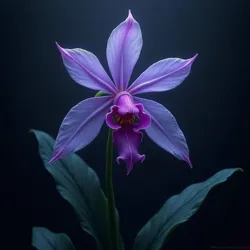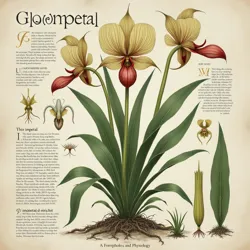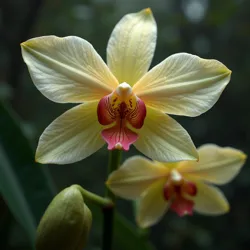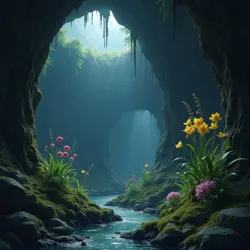Gloompetal Orchid

The Gloompetal Orchid, also known as Umbral Bloom or Nyxflora, a rare bioluminescent plant from the Underdark.
Gloompetal Orchid
Umbral Bloom, Nyxflora
deepest caverns of the Underdark
Nyctorchis
15 to 30 centimeters
5 to 8 centimeters
vulnerable
The *Gloompetal Orchid, known in the cant of Underdark apothecaries and herbalists as the Umbral Bloom or Nyxflora*, is a rare and highly prized species of flowering plant endemic to the deepest caverns of the Underdark. Esteemed for its unique bioluminescent properties and potent nectar, the Gloompetal Orchid holds a significant place in Underdark culture, particularly within the alchemical traditions of the Nigritude Gnomes and the arcane practices of certain Drow Sects. Its ethereal beauty and elusive nature have also made it a subject of fascination and reverence among various Under-mountain folk, featuring prominently in folklore, medicinal practices, and, most notably, as a crucial ingredient in the celebrated Pheromone Philtres of the gnome alchemist Claus Jabbers.
Unlike surface orchids that thrive in sun-drenched environments, the Gloompetal Orchid has adapted to the perpetual twilight and unique geochemical conditions of the Underdark. It is found exclusively in subterranean ecosystems, often in proximity to geothermal vents, subterranean rivers, and areas rich in specific mineral deposits. Its luminous petals, which emit a soft, cool light in shades of violet and deep indigo, are its most striking feature, serving not only to attract nocturnal pollinators but also playing a crucial role in its alchemical and magical applications. The orchid's rarity and the challenging conditions of its growth have contributed to its high value and the mystique surrounding it, making it a sought-after component for various Underdark concoctions and rituals.
Botanical Characteristics
The Gloompetal Orchid, scientifically classified within a unique genus Nyctorchis (meaning "night orchid"), exhibits several distinctive botanical characteristics that set it apart from its surface-dwelling relatives. Its morphology reflects its adaptation to a lightless environment and its symbiotic relationships with the Underdark ecosystem.
 Detailed botanical illustration of the Gloompetal Orchid, highlighting its unique adaptations to the Underdark environment.
Detailed botanical illustration of the Gloompetal Orchid, highlighting its unique adaptations to the Underdark environment.Morphology and Physiology
The Gloompetal Orchid is a terrestrial orchid, typically growing to a height of 15 to 30 centimeters. Its root system is adapted to anchor itself in rocky crevices and nutrient-poor substrates, often forming mycorrhizal associations with specific types of subterranean fungi, similar to the symbiotic relationships observed between many terrestrial orchids and fungi in surface environments. These fungal partners are believed to provide the orchid with essential nutrients absorbed from the mineral-rich Underdark environment.
The orchid's stem is slender and wiry, supporting a rosette of dark, leathery leaves near its base. These leaves are typically a deep green, almost black in coloration, and possess a waxy cuticle that reduces water loss in the dry cave air. Unlike the vibrant green leaves of surface orchids, the Gloompetal Orchid's foliage is adapted for maximum light absorption in extremely low-light conditions.
The most notable feature of the Gloompetal Orchid is its inflorescence, which consists of a single, or occasionally up to three, blooms atop a delicate stalk. The flower itself is relatively large compared to the plant's overall size, typically measuring 5 to 8 centimeters in diameter. The petals are the source of its luminescence, composed of specialized cells called Lucifersomes that contain bioluminescent compounds. These compounds, unlike those found in many bioluminescent fungi, are not based on luciferin-luciferase systems, but rather on a unique type of organic molecule that emits light through a process akin to chemiluminescence, triggered by subtle changes in humidity and air pressure within the cave environment. The emitted light is a cool, ethereal glow, ranging in color from deep violet to indigo, and is most intense during periods of high humidity or subterranean air currents.
The orchid's reproductive structures are also adapted to its subterranean habitat. It produces a potent, nectar-like substance within its nectary that is highly attractive to specific species of cave-dwelling insects and arthropods, which serve as its primary pollinators. These pollinators, often blind or possessing highly developed non-visual sensory organs, are drawn to the orchid not only by its luminescence but also by the unique aromatic compounds emitted by its petals, which are distinct from the pheromonal attractants produced by the Mycelia Aphrodisia fungus, but nonetheless possess their own subtle allure. The orchid's seeds are exceptionally small and lightweight, adapted for dispersal by air currents within the cave systems, allowing it to colonize new locations within the Underdark.
Habitat and Distribution
The Gloompetal Orchid's distribution is highly restricted, even within the vast expanse of the Underdark. It is primarily found in deep cavern systems characterized by specific environmental conditions. These include:
- Geothermal Activity: The orchid thrives in areas with moderate geothermal activity, often near vents or fissures that release warm, mineral-rich air. The slightly elevated temperatures and the presence of specific minerals, such as sulfur and certain rare earth elements, are crucial for its growth and bioluminescence.
- Subterranean Water Sources: Proximity to underground rivers or aquifers is another key factor. The orchid requires consistently high humidity levels and access to water sources, although it is adapted to tolerate periods of drought by storing moisture in its fleshy roots.
- Specific Cave Formations: Gloompetal Orchids are most commonly found growing on cave walls and ceilings, often in crevices and alcoves that provide some protection from strong air currents and cave-ins. They prefer limestone or gypsum cave formations, where the rock provides a suitable substrate and releases minerals essential for their growth.
- Limited Light Penetration: While completely devoid of sunlight, the Gloompetal Orchid can tolerate extremely low levels of light, including faint bioluminescence from other Underdark organisms or ambient magical light sources that may permeate certain cave systems. However, direct exposure to surface sunlight is lethal to the plant.
Geographically, the Gloompetal Orchid is known to be concentrated in specific regions of the Underdark, particularly in the deeper cave systems beneath mountainous ranges and volcanic regions. Reports from Under-mountain explorers and gnome cartographers indicate that significant populations exist in the caverns beneath the Serpent's Spine mountain range and within the labyrinthine tunnels beneath the Obsidian Peaks, regions renowned for their extensive cave networks and geothermal activity. However, its rarity and the difficulty of accessing its preferred habitats mean that it remains a relatively uncommon sight, even for seasoned Underdark travelers.
Conservation Status
Due to its restricted habitat, slow growth rate, and the increasing pressures of Underdark exploration and resource extraction, the Gloompetal Orchid is considered a vulnerable species. While not officially classified as endangered, its populations are believed to be declining in certain areas due to habitat destruction and over-harvesting.
The primary threats to Gloompetal Orchid populations include:
- Cave Exploration and Development: Expansion of Underdark settlements, mining operations, and exploratory expeditions can directly destroy orchid habitats or alter the delicate environmental conditions necessary for their survival.
- Over-harvesting: The high demand for Gloompetal Orchids in alchemy, medicine, and magical practices has led to unsustainable harvesting in some regions. While some cultivation efforts exist, they are not yet widespread enough to alleviate pressure on wild populations.
- Climate Change (Subterranean): While seemingly insulated from surface climate change, Underdark ecosystems are not entirely immune to broader environmental shifts. Changes in geothermal activity, subterranean water flows, and air currents can all impact Gloompetal Orchid habitats.
- Pollution: Mining and industrial activities in the Underdark can introduce pollutants into cave systems, affecting water quality and air composition, which can be detrimental to the orchid and its symbiotic partners.
Conservation efforts are limited by the challenging environment and the decentralized nature of Underdark governance. However, some gnome and dwarven communities have established protected areas within cave systems known to harbor Gloompetal Orchid populations. Sustainable harvesting practices and cultivation initiatives are also being explored, particularly by gnome alchemists who rely on the orchid for their craft. The long-term survival of the Gloompetal Orchid will depend on increased awareness of its vulnerability and concerted efforts to protect its fragile subterranean habitats.
Role in Claus Jabbers' Philtres
The Gloompetal Orchid is not merely an exotic Underdark flower; it is a critical, albeit rare, ingredient in the pheromone philtres crafted by Claus Jabbers. Its unique properties contribute significantly to the philtres' efficacy and their specific effects on the Drow.
 Gloompetal Orchid nectar being harvested for use in Claus Jabbers' pheromone philtres, showing delicate extraction techniques.
Gloompetal Orchid nectar being harvested for use in Claus Jabbers' pheromone philtres, showing delicate extraction techniques.Nectar as a Pheromonal Catalyst
While the primary pheromonal component of Claus Jabbers' philtres is derived from the Mycelia Aphrodisia fungus, the nectar of the Gloompetal Orchid serves as a crucial catalyst and modulator in the alchemical formula. It does not possess inherent pheromonal properties that directly induce attraction in Drow females, but rather it acts to refine and amplify the effects of the Mycelia Aphrodisia extract, making the philtres more potent and nuanced in their action.
The orchid nectar contains a complex cocktail of organic compounds, including unique alkaloids, terpenes, and volatile oils. These compounds, when processed using cryo-distillation techniques favored by Claus, undergo subtle transformations that enhance their catalytic properties. In particular, the nectar is believed to:
- Increase Pheromonal Receptor Sensitivity: Certain compounds in the nectar are thought to temporarily heighten the sensitivity of pheromone receptors in Drow females, making them more receptive to the Mycelia Aphrodisia pheromones and amplifying their effects.
- Modulate Emotional Response: The orchid nectar contains psychoactive substances that can subtly influence mood and emotional states. In the context of the philtres, these substances are believed to create a state of heightened receptivity and emotional openness in Drow females, making them more susceptible to the philtre's alluring influence.
- Enhance Subtlety and Nuance: The Gloompetal Orchid nectar is crucial for creating philtres with varying degrees of potency and specific effects. By carefully adjusting the concentration of orchid nectar in the formula, Claus can create philtres that range from subtly persuasive to overwhelmingly alluring, allowing for a more refined and targeted application of his alchemical craft.
- Stabilize the Philtre: The nectar also acts as a stabilizing agent in the philtre formula. The pheromonal compounds from Mycelia Aphrodisia are inherently volatile and prone to degradation. The orchid nectar, through complex alchemical interactions, helps to preserve the potency and longevity of the philtre, ensuring its effectiveness over time.
Without the Gloompetal Orchid nectar, Claus Jabbers' philtres would be significantly less effective and lack the subtle nuances that have made him renowned within Drow society. The orchid is therefore an indispensable, albeit closely guarded, component of his alchemical repertoire.
Harvesting and Preparation for Philtres
The scarcity of the Gloompetal Orchid and the delicate nature of its nectar necessitate careful and specialized harvesting techniques. Claus Jabbers, and those who seek to replicate his philtres, must undertake perilous expeditions to the orchid's remote subterranean habitats and employ meticulous methods to extract and preserve its precious nectar.
Harvesting typically occurs during specific lunar phases, believed to coincide with periods of peak nectar production within the orchid. Gnome nectar-collectors, often trained in the esoteric arts of subterranean botany, venture into the orchid's cavernous domains, equipped with specialized tools and protective gear. The nectar is carefully extracted from the orchid's nectary using delicate glass pipettes or specialized capillary tubes, ensuring minimal damage to the plant and maximizing nectar yield.
The harvested nectar is immediately preserved in airtight obsidian vials, shielding it from surface light and air exposure, which can degrade its delicate compounds. Often, the nectar is mixed with inert subterranean oils or distilled spirits to further stabilize it during transport back to alchemical laboratories.
In Claus Jabbers' workshop, the Gloompetal Orchid nectar undergoes a series of alchemical processes before being incorporated into his philtre formulas. These processes, often shrouded in secrecy, are believed to involve:
- Cryo-distillation: As mentioned previously, cryo-distillation is a key technique for refining the nectar, separating its various components and isolating the specific compounds that contribute to its catalytic and modulating properties.
- Lunar Infusion: Some accounts suggest that Claus exposes the nectar to specific phases of subterranean moonlight, believing that lunar energies further enhance its potency and align it with the natural pheromonal cycles of the Drow.
- Mineral Fortification: The nectar may be fortified with trace amounts of specific Underdark minerals, believed to synergize with its organic compounds and further amplify its alchemical effects.
- Esoteric Incantations: While not strictly alchemical, some narratives hint that Claus incorporates subtle magical incantations or gnome earth-chants during the preparation process, imbuing the nectar with subtle enchantments that enhance its desired properties.
The meticulous and labor-intensive process of harvesting and preparing Gloompetal Orchid nectar underscores its rarity and value. It is not merely a passive ingredient in Claus Jabbers' philtres, but an active and transformative component, imbued with both botanical potency and alchemical refinement.
Cultural Significance in the Underdark
Beyond its alchemical applications, the Gloompetal Orchid holds considerable cultural significance within various Underdark societies, particularly among the Under-mountain folk and the Drow Society. Its ethereal beauty, bioluminescence, and association with hidden depths have imbued it with symbolic meaning and practical uses that extend beyond the realm of alchemy.
 Gloompetal Orchids growing in their natural Underdark habitat, near geothermal vents and subterranean water sources within a cave system.
Gloompetal Orchids growing in their natural Underdark habitat, near geothermal vents and subterranean water sources within a cave system.Folklore and Symbolism
In Underdark Folklore, the Gloompetal Orchid is often associated with mystery, allure, and the hidden beauty of the subterranean world. Its luminous petals are seen as beacons in the darkness, guiding lost travelers or revealing secret pathways within the labyrinthine cave systems. Among some Under-mountain cultures, it is believed to be a flower of the underworld, a gift from subterranean deities or spirits, representing both the beauty and the potential dangers of the deep earth.
The orchid's bioluminescence is often interpreted as a symbol of hope and resilience in the face of darkness. It is seen as a reminder that even in the deepest, most lightless environments, beauty and life can flourish. This symbolism resonates particularly strongly with the Under-mountain folk, who have adapted to the challenges of subterranean existence and found beauty and sustenance in the seemingly inhospitable depths.
In Drow culture, the Gloompetal Orchid's symbolism is more complex and multifaceted. Its rarity and allure align with Drow aesthetics, which often value the exotic, the mysterious, and the subtly powerful. The orchid's association with pheromonal effects, through its role in Claus Jabbers' philtres, may also contribute to its symbolic significance within Drow society, where pheromonal communication and manipulation play a subtle but important role in social dynamics. However, Drow interpretations of the orchid are often intertwined with their religious beliefs and their complex relationship with the surface world, adding layers of cultural nuance to its symbolic meaning.
Medicinal and Ritual Uses
Beyond folklore, the Gloompetal Orchid also has practical applications in Underdark cultures. Its nectar, in addition to its alchemical properties, is believed to possess medicinal qualities. In traditional Under-mountain herbalism, diluted orchid nectar is used as a mild sedative, a cough suppressant, and a topical antiseptic. It is also sometimes incorporated into healing poultices and balms for its purported regenerative properties. However, due to its rarity, medicinal use of the Gloompetal Orchid is typically reserved for special occasions or for treating serious ailments.
In certain Drow rituals, particularly those associated with nocturnal deities or subterranean spirits, Gloompetal Orchids may be used as offerings or as decorative elements to enhance the atmosphere of the ceremony. The orchid's luminescence is believed to create a sacred space, invoking the presence of otherworldly entities and facilitating communication with the spiritual realm. However, the use of Gloompetal Orchids in Drow rituals is not as widespread as its alchemical applications, and its significance in this context varies among different Drow sects and traditions.
Dangers and Precautions
Despite its beauty and beneficial properties, the Gloompetal Orchid is not without its dangers. The undiluted nectar, in large quantities, can be toxic, causing hallucinations, disorientation, and even respiratory distress. Under-mountain herbalists and alchemists are well aware of these risks and handle the orchid and its nectar with caution.
Furthermore, the orchid's bioluminescence, while alluring, can also attract dangerous cave creatures. Certain species of Underdark predators are drawn to the orchid's glow, using it to locate prey or to ambush unsuspecting travelers. Harvesting Gloompetal Orchids often requires navigating hazardous terrain and evading or deterring these nocturnal predators, adding to the challenges of obtaining this prized plant.
The Gloompetal Orchid, therefore, is a plant of both wonder and caution in the Underdark. Its beauty and potent properties are highly valued, but its rarity, toxicity, and the dangers associated with its habitat necessitate respect and careful handling. It embodies the duality of the Underdark itself: a realm of hidden beauty and profound resources, but also a place of peril and unpredictable forces.
Cultivation and Harvesting
Given the high demand for Gloompetal Orchids and their vulnerability in the wild, efforts have been made to cultivate them within controlled subterranean environments. However, successful cultivation remains challenging due to the orchid's specific environmental requirements and slow growth rate.
Subterranean Greenhouses and Orchid Gardens
Some gnome and dwarven communities, particularly those with established alchemical traditions, have developed subterranean greenhouses or orchid gardens dedicated to Gloompetal Orchid cultivation. These facilities are typically located deep within cave systems, replicating the orchid's natural habitat as closely as possible. Key features of these cultivation sites include:
- Geothermal Heating: Geothermal vents or artificial heating systems are used to maintain the slightly elevated temperatures preferred by the orchid.
- Humidity Control: Sophisticated humidity control systems, often utilizing subterranean water sources and ventilation shafts, are employed to maintain consistently high humidity levels.
- Mineral-Rich Substrates: Cultivation beds are prepared using specific rock and mineral mixtures, mimicking the orchid's natural substrate and providing essential nutrients.
- Artificial Bioluminescence: In some advanced cultivation facilities, artificial bioluminescent light sources are used to supplement the orchid's natural light cycle and potentially enhance its growth and nectar production.
- Pest and Disease Control: Careful monitoring and organic pest control methods are employed to protect the orchids from subterranean pests and fungal diseases.
Despite these efforts, Gloompetal Orchid cultivation remains a delicate and labor-intensive process. The orchids are slow to mature, often taking several years to reach flowering stage, and their nectar production is highly variable depending on environmental conditions. Cultivated orchids also tend to produce less potent nectar compared to their wild counterparts, further limiting their appeal for high-end alchemical applications.
Sustainable Harvesting Practices
Recognizing the limitations of cultivation and the importance of preserving wild populations, some Underdark communities have implemented sustainable harvesting practices for Gloompetal Orchids. These practices aim to minimize the impact on wild populations and ensure the long-term availability of the orchid. Key elements of sustainable harvesting include:
- Quota Systems: Harvesting quotas are established based on population surveys and ecological assessments, limiting the amount of orchid nectar that can be collected from specific areas.
- Selective Harvesting: Harvesters are trained to selectively collect nectar from mature orchids, leaving younger plants and seed pods undisturbed to ensure continued propagation.
- Habitat Protection: Efforts are made to protect known Gloompetal Orchid habitats from development, pollution, and destructive harvesting practices.
- Community Involvement: Local communities are involved in monitoring orchid populations, enforcing harvesting regulations, and participating in conservation efforts.
- Traditional Knowledge Integration: Traditional Under-mountain knowledge about orchid ecology and sustainable harvesting practices is incorporated into modern conservation strategies.
These sustainable harvesting initiatives are not universally adopted, and illegal poaching of Gloompetal Orchids remains a problem in some regions. However, increasing awareness of the orchid's vulnerability and the long-term benefits of sustainable practices are gradually leading to greater conservation efforts and a more responsible approach to harvesting this precious Underdark resource.
Related Flora
The Gloompetal Orchid is just one example of the diverse and fascinating flora that has adapted to the unique conditions of the Underdark. The subterranean realm is home to a wide array of plant life, ranging from bioluminescent fungi and cave mosses to subterranean ferns and other specialized flowering plants. These organisms, collectively known as Underdark Flora, have evolved remarkable adaptations to survive and thrive in a world of perpetual darkness, limited resources, and unique geochemical environments. Further exploration of Underdark botany reveals a hidden world of botanical wonders, as captivating and mysterious as the Gloompetal Orchid itself.